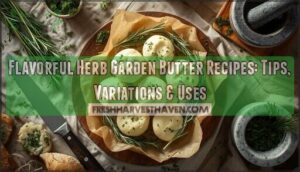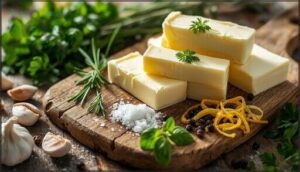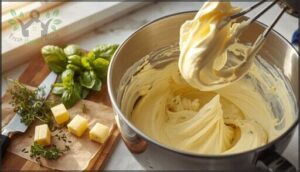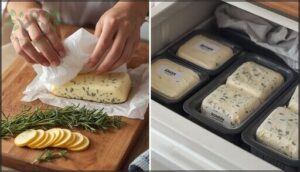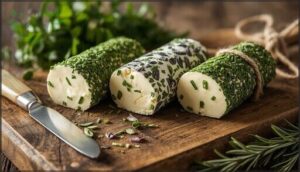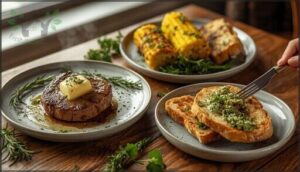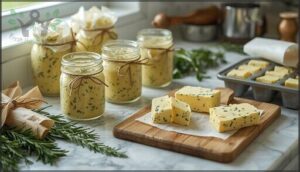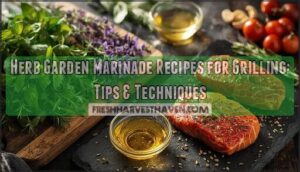This site is supported by our readers. We may earn a commission, at no cost to you, if you purchase through links.
You probably have butter in your fridge right now, but you’re missing out on its full potential. Adding fresh herbs transforms plain butter into a flavor powerhouse that elevates everything from grilled steak to morning toast.
The French perfected this technique centuries ago, blending softened butter with garden herbs to create what they call “beurre composé.” It’s one of those kitchen secrets that sounds fancy but takes less than five minutes to master.
Whether you snip herbs from your backyard or grab a bunch from the market, flavorful herb garden butter recipes give you an easy way to add restaurant-quality taste to everyday meals. The best part? You can customize the blend to match whatever you’re cooking.
Table Of Contents
Key Takeaways
- Herb butter combines softened butter with fresh herbs to create compound butter that elevates everyday dishes from grilled meats to toast, and you can store it in the fridge for 1-2 weeks or freeze it for up to 12 months.
- Use unsalted butter with 82-84% butterfat content and fresh herbs with firm stems and vibrant leaves, then soften the butter to 65-70°F before mixing to ensure even distribution and proper texture.
- Classic combinations like parsley-chive-dill or garlic-thyme work beautifully, but you can also experiment with spicy variations using jalapeños and red pepper flakes or smoky versions with paprika and roasted garlic.
- Beyond spreading on bread, herb butter melts perfectly over hot grilled proteins to create an instant sauce, mixes into mashed potatoes or scrambled eggs for enhanced flavor, and transforms roasted vegetables into restaurant-quality sides.
What is Herb Garden Butter?
Herb garden butter is a compound butter that combines softened butter with fresh herbs and aromatics to create a rich, flavorful spread. It’s an easy way to transform simple ingredients from your garden into something that elevates everything from grilled steak to warm bread.
Let’s look at what makes this kitchen staple so adaptable and why fresh herbs make all the difference.
Definition and Origins
Compound butter—often called herb butter—began as a simple kitchen fix, blending fresh herbs into softened butter for practical, everyday use. You’ll find its roots in French cuisine, yet the technique appears in historical recipes from ancient Rome to rural farmhouses.
Over time, global adaptations turned this blend into a starring flavor boost for countless dishes. It’s incredibly easy to make delicious compound butter with minimal ingredients.
Benefits of Using Fresh Herbs
Fresh herbs turn herb butter into pure magic. You get enhanced flavor—aromas leap out, flavors sing, and each bite feels brighter thanks to fresh aromatics and a bolder flavor profile.
Fresh herbs transform butter into pure magic, making aromas leap and flavors sing with every bite
There’s real nutritional value, too, like higher vitamin K and powerful antioxidant properties. Increased consumption of food-based herbs can have over-reaching health benefits.
Plus, you’ll save money and waste by using up garden herbs in your butter.
Common Uses in Cooking
When you’ve got a tub of herb butter, you open doors to simple, flavorful dishes. Spread it on warm bread or melt it over grilled meats—the results turn everyday food into something special. Mix into eggs or swirl a pat into sauces. It brings instant flavor combinations to:
- Grilled meats
- Roasted vegetables
- Main dishes
- Flavoring breads
Essential Ingredients for Herb Butter
Building great herb butter starts with picking the right ingredients. The kind of butter, herbs, and little extras you choose make all the difference.
Here’s what you’ll want to have on hand.
Choosing The Best Butter
Your butter choice sets the stage for everything that follows. Opt for unsalted butter so you control seasoning, and look for higher butterfat content—around 82-84%—for richer flavor and creamier texture.
Grass-fed or organic options bring deeper flavor profiles and better nutritional benefits. Freshness matters too, as it directly impacts how well your herbs shine through in the final flavor combinations.
Selecting Fresh Herbs
Vibrant leaves, firm stems, and potent aroma tell you everything when selecting herbs for your butter. Visual indicators matter—crisp, green herbs without wilting or brown spots deliver the best flavor profiles.
Consider these harvesting practices and storage guidelines for cooking with herbs:
- Pick herbs early morning after dew dries for maximum oil retention
- Check stems for firmness and avoid any sliminess
- Use sharp cutting techniques to prevent bruising
- Store wrapped in damp towels to maintain freshness longer
Flavor-Boosting Additions (Garlic, Lemon, Etc.)
Beyond herbs, you can transform basic butter into something special. Garlic preparation varies from fresh and pungent to roasted and sweet, each delivering distinct flavor profiles.
Lemon zest and lemon juice brighten rich butter, while salt sharpens every taste. Try pickled additions for tang, umami enhancement through Worcestershire sauce, or global spices like smoked paprika.
These flavor combinations reveal creative possibilities.
Step-by-Step Herb Butter Preparation
Making herb butter is easier than you might think, but a few simple techniques make all the difference. The key steps involve properly softening your butter, mixing in your herbs evenly, and storing everything correctly so it stays fresh.
Let’s walk through each part of the process, including how to fix common problems that pop up along the way.
Softening and Mixing Techniques
Getting your butter to the right spreadable texture—around 65-70°F—makes all the difference in how well your herbs blend in. You can speed things up by cutting cold butter into chunks or grating it, which cuts softening time by half.
- Use an electric mixer with a paddle attachment for 7-8 minutes to get that light, airy consistency
- Mix by hand with a fork if you prefer, though it takes roughly twice as long
- Chop herbs finely before blending so flavors distribute evenly without clumping
- Stop mixing once herbs look consistent throughout—overmixing can cause separation and ruin your butter’s texture
Shaping and Storing The Butter
Roll your freshly mixed herb butter into a tight log using parchment paper or plastic wrap, twisting the ends to seal in flavor. You can freeze it for up to 12 months in an airtight container, or refrigerate for 1-2 months.
Slice the log into coins before freezing herb butter—portioning ideas like this make storing herb butter practical. Proper packaging materials and food storage methods preserve those vibrant herb notes.
Troubleshooting Common Issues
If your herb butter feels watery or separates, you’ve likely added too much liquid from wet ingredients. Pat fresh herbs dry before mixing, and stick to about 2 tablespoons of add-ins per stick to avoid texture problems and flavor imbalance.
Watch for spoilage signs like sour smells or discoloration—these signal your flavorful creation has passed its shelf life.
Classic Herb Garden Butter Recipes
These three classic recipes are the foundation of any good herb butter collection. Each one brings a different flavor profile to your table, from bright and fresh to rich and savory.
Let’s start with the simplest combinations that deliver the most impact.
Parsley, Chive, and Dill Butter
You can’t go wrong combining parsley, dill, and chives in your herb butter. These fresh herbs create bright, herbaceous flavor combinations that work beautifully over grilled fish or warm bread.
Use about ¾ cup of each herb per pound of softened butter, mixing until smooth. The health benefits include vitamin K and antioxidants.
Try freezing methods like rolling into logs or portioning in molds for quick serving suggestions anytime.
Garlic and Thyme Compound Butter
If you want a richer, more earthy flavor combination, garlic and thyme make a superb herb butter recipe. Roast five cloves of garlic first to mellow the bite, then blend with one tablespoon of fresh thyme into a cup of softened butter.
This blend excels in culinary applications like:
- Melting over steak or chicken
- Tossing with roasted vegetables
- Spreading on crusty bread
- Mixing into mashed potatoes
Store your finished herb butter wrapped tightly in the fridge for two weeks, or freeze for six months.
Lemon Zest and Scallion Butter
Bright citrus notes wake up your palate when you combine fresh lemon zest with chopped scallions. Mix 1/2 teaspoon of finely grated lemon zest and two tablespoons of minced scallions into 1/4 cup softened butter, adding 1/4 teaspoon salt for balance.
| Component | Amount | Purpose |
|---|---|---|
| Unsalted Butter | 1/4 cup (4 tbsp) | Creamy base |
| Lemon Zest | 1/2 teaspoon | Citrus brightness |
| Scallions | 2 tablespoons | Fresh onion flavor |
| Lemon Juice | 1-2 teaspoons | Acidity boost |
| Salt & Pepper | 1/4 teaspoon each | Seasoning balance |
This citrus-herb balance shines on grilled fish, lobster, or warm bread.
Creative Flavor Variations to Try
Once you’ve mastered the basics, it’s time to push beyond the usual parsley and garlic combo. These creative variations let you dial up the heat, add a smoky depth, or even skip the dairy altogether.
Here are three flavor twists that’ll give your herb butter a whole new personality.
Spicy Herb Kick Butter
If you love a little heat, this spicy herb kick butter brings bold flavor to your table. The flavor combination of fresh herbs with chili varieties creates exciting flavor complexity that transforms ordinary dishes. About 40-60% of home cooks prefer spicy or flavored butters for grilled meats and vegetables, making this variation a real crowd-pleaser. This spicy herb butter follows current culinary trends, with flavored butter searches jumping 184% in 2025.
Here’s what you’ll need:
- Red pepper flakes – Start with 1-2 teaspoons for moderate spice level
- Fresh jalapeños or habaneros – Choose your chili varieties based on desired heat (habaneros pack up to 350,000 SHU)
- Lime zest – Adds brightness and boosts flavor profile by 25-30%
- Cilantro and parsley – Fresh herbs balance the heat beautifully
- Garlic and salt – Essential flavor-boosting foundations
The shelf life extends to 4-6 months when frozen properly, so you can make big batches. Mix softened butter with your chosen peppers, herbs, and seasonings until smooth. Roll into a log, wrap tightly, and freeze. When you’re ready to use it, slice off a pat and watch it melt over grilled steak, corn on the cob, or roasted vegetables. The heat builds gradually, creating layers of flavor that keep you coming back for more.
Smoky Paprika and Herb Blend
Smoky paprika brings another layer of depth to your herb butter arsenal. This Spanish or Hungarian spice, dried over oak fires, pairs beautifully with rosemary, parsley, and roasted garlic.
The smoky flavor profile complements grilled chicken and roasted vegetables perfectly. Mix softened butter with 1-2 teaspoons smoked paprika, fresh herbs, and roasted garlic heads (400°F for 30-40 minutes).
The fat-soluble antioxidants absorb easily, supporting nutrient retention while delivering rich, complex taste.
Dairy-Free Herb Butter Alternatives
Beyond dairy, you can create rich herb butter with plant-based alternatives like Miyoko’s or other vegan butter brands. These dairy-free options offer allergen-free choices while reducing environmental impact.
Try these sustainable sourcing approaches:
- Use coconut-oil-based plant-based butter for tropical notes
- Blend tahini with olive oil for nutrient-dense spreads
- Mix avocado with fresh herbs for whole-food alternatives
Homemade recipes deliver clean-label plant-based nutrition without compromising flavor.
Delicious Ways to Use Herb Butter
You’ve made a beautiful batch of herb butter, and now it’s time to put it to work.
This compound butter isn’t just for show—it transforms everyday meals into something special with minimal effort.
Here are three ways you can use herb butter to upgrade your cooking.
Melting Over Grilled Meats and Seafood
You can transform grilled meats and seafood by letting herb butter melt right over the hot surface. The butter creates a creamy sauce emulsion as it hits the heat, boosting steak flavor and triggering seafood aroma release.
Fresh herbs in your flavor combinations deliver a higher flavor intensity score, while the rapid butter melt rate coats proteins evenly, enhancing every bite’s flavor profile.
Spreading on Bread and Vegetables
With bread pairings and roasted vegetables, herb butter shines as your go-to spread. The flavor intensity boosts sensory perception, making every bite memorable. Consumer preferences lean toward garlic herb blends on crusty baguettes and grilled corn. Try these favorites:
- Warm sourdough with parsley butter
- Roasted carrots drizzled generously
- Grilled asparagus for vegetable enhancement
- Toasted baguette slices
- Steamed broccoli with fresh herbs
The butter transforms simple ingredients into flavor-packed sides.
Mixing Into Mashed Potatoes or Eggs
Herb butter becomes a flavorful condiment when folded into mashed potatoes or scrambled eggs. The key to effective flavor dispersion is adding room-temperature butter at the end, which helps prevent emulsion and retains texture. Consumer ratings indicate that three-herb combinations are the most popular.
Use the following guide to enhance your meals with herb butter:
| Dish | Butter Amount | Best Herbs |
|---|---|---|
| Mashed potatoes (1 kg) | 1 stick (113g) | Parsley, chives, dill |
| Scrambled eggs (4) | 2 tablespoons | Parsley, dill, chives |
| Egg scramble (serving) | 1-2 tablespoons | Sage, rosemary (1 tbsp each) |
| Potato purée (rich) | 2-4 sticks | Thyme, garlic, parsley |
| Breakfast eggs (2) | 1 tablespoon | Chives, tarragon, parsley |
For maximum flavor intensity, mix herb butter into hot dishes right before serving. This timing preserves the fresh herb taste while creating smooth flavor combinations and pairings. Recipe variations and tips include using milder herbs like parsley in larger amounts and stronger herbs sparingly.
Storage Tips and Nutritional Insights
Once you’ve made your herb butter, you’ll want to keep it fresh and know what you’re getting nutrition-wise.
Proper storage can extend its life for weeks or even months, and a few smart tips will help you use it more easily.
Let’s cover how to store it right, portion it out, and understand what’s in each serving.
Refrigeration and Freezing Guidelines
You can keep your herb butter fresh for up to 2 weeks in the refrigerator, or freeze it for 4–6 months using an airtight container or vacuum seal method. Wrap it in parchment paper before freezing to prevent contamination risks.
Thaw slowly in the fridge for best results. Quality indicators like off-flavors mean it’s time to toss it. Safe refreezing works if it hasn’t sat out too long.
Portioning and Serving Suggestions
You’ll want to slice your herb butter into ½ tablespoon rounds for perfect serving sizes on grilled meats or warm bread. For easy portioning, roll your butter into logs and freeze using an ice cube tray method, giving you ready-to-use portions.
Present sliced rounds as an appetizer, or use portioning tools like small molds for elegant presentation styles that match consumer preferences and dish variability.
Nutritional Information and Health Tips
Beyond portion control, understanding the nutritional profile helps you enjoy herb butter wisely. One tablespoon packs 90–102 calories and 10–11.5 grams of total fat, with 7 grams of saturated fat. That’s significant for heart health.
The good news? Fresh herbs add antioxidants and vitamin K without extra cholesterol or sodium. Use moderate amounts in a balanced diet to boost flavor while managing your intake smartly.
Frequently Asked Questions (FAQs)
Can herb butter be made with dried herbs?
Need a shortcut when fresh herbs aren’t on hand? You can make herb butter with dried herbs using a 1:3 ratio—one teaspoon dried for every tablespoon fresh—though the flavor won’t be quite as vibrant.
What herbs should never be mixed together?
When mixing fresh herbs for aromatic blends, avoid pairing licorice root with hawthorn due to cardiac rhythm risks. Skip combining garlic with ginkgo, as herb interaction risks increase bleeding potential.
Regulatory oversight remains limited, so source carefully to avoid heavy metal accumulation and adulteration concerns.
How long does homemade herb butter stay fresh?
Homemade herb butter can vanish from your fridge faster than you’d think! In an airtight container, it stays fresh for one to two weeks refrigerated, or up to six months frozen in parchment paper.
Can you use salted butter instead of unsalted?
You can use salted butter, but you’ll need to reduce or skip added salt in your recipe.
Salted butter contains about ¼ to ½ teaspoon salt per stick, affecting flavor balance and texture slightly.
Does herb butter work well in baking recipes?
You can butter believe it works! Herb butter brings flavor profiles to muffins, breads, and rolls while enhancing texture.
Fresh herbs retain 73-82% potency after baking, proving these ingredients deliver both taste and nutritional retention in baking applications.
Conclusion
Think of herb butter as your kitchen’s Swiss Army knife—one simple preparation unlocks dozens of culinary possibilities. You’ve learned the techniques, explored flavorful herb garden butter recipes, and discovered creative variations that suit any meal.
Now it’s time to experiment with your favorite herbs and find combinations that make your cooking shine. Start small, taste often, and don’t be afraid to adjust the ratios. Your homemade herb butter will quickly become irreplaceable.
- https://eatmorebutter.com/making-herb-infused-compound-butters/
- https://farmtojar.com/preserving-fresh-herbs-as-herbal-compound-butters/
- https://www.gettystewart.com/herb-butter-using-fresh-herbs/
- https://ocadoretail.com/media-centre/press-releases/spread-the-word-flavoured-butter-is-the-new-kitchen-essential/
- https://www.eatthismuch.com/calories/herb-butter-2255354

